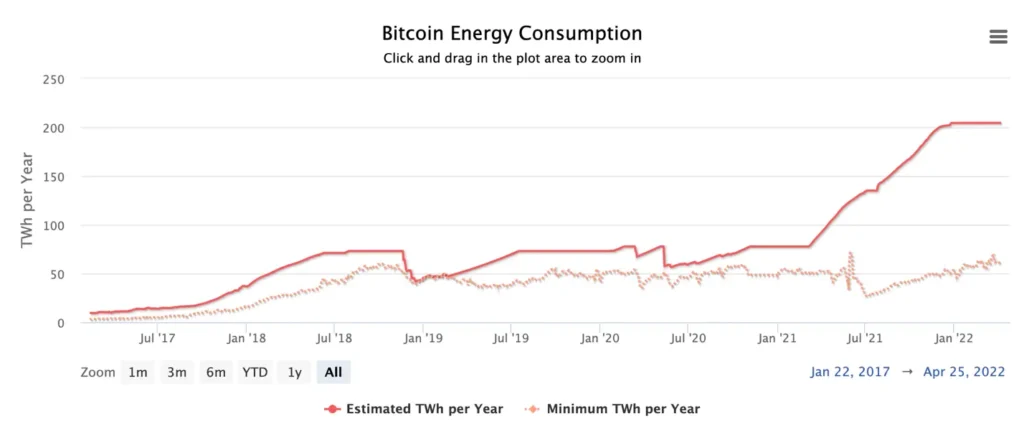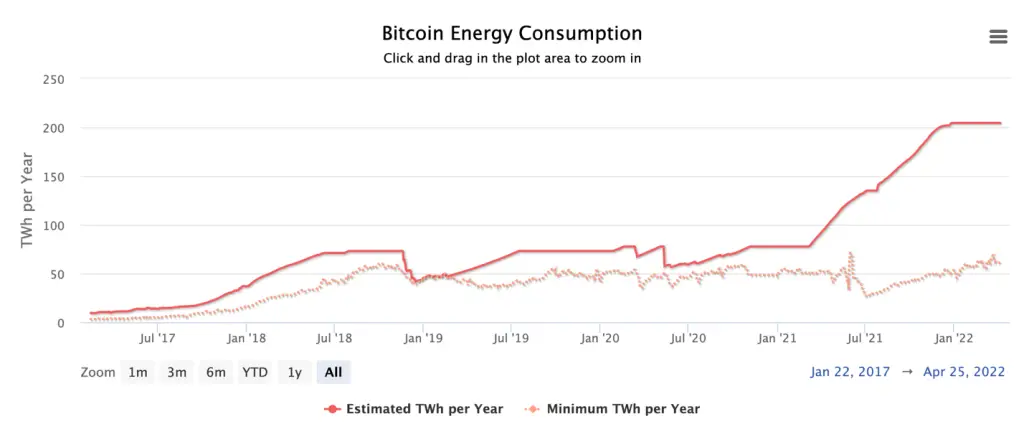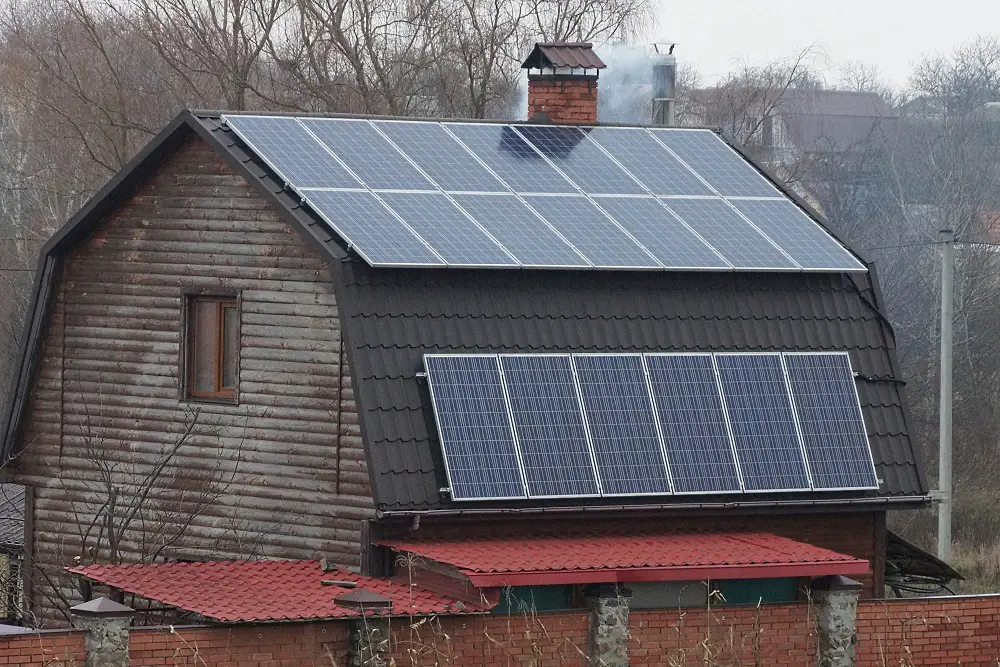An unintended consequence of this digital gold is that its demanding proof-of-work algorithm is energy-intensive, consuming enormous amounts of energy to run the Bitcoin network. The annual electricity consumption of Bitcoin is equivalent to 204.5 TWh per year and produces over 114 million tons of CO2 equivalent.
If Bitcoin were a country, it would rank as the 23rd highest energy-consuming country. The transaction of a single Bitcoin releases 1,177 kg of CO2 equivalent and 2,111 kWh of electricity (equivalent to 1.4 million Visa transactions).


Bitcoin’s Energy Consumption Index is determined as follows:
- Calculate the total mining revenues (USD)
- Estimate the percentage of revenue spent on electricity
- Find out how much miners pay for electricity ($/kWh)
- Converts costs to electricity consumption
Sustainability of Bitcoin
Bitcoin is commonly referred to as “mining for digital gold.” One Bitcoin’s worth of gold mined would result in 17 tonnes of CO2, whereas the energy to mine for a single Bitcoin results in 336 tonnes of CO2 emissions.
Thus, Bitcoin is 20 times more unsustainable than mining for gold. There are more sustainable consensus algorithms than Bitcoin’s proof-of-work, such as proof-of-stake where coin owners can create the blocks (instead of miners). Switching to proof-of-stake would use 99.95% less energy than the current Bitcoin network.
Renewables are an intermittent source of energy whereas Bitcoin mining requires constant power, running 24/7. This constant power is referred to as “baseload” energy, which is historically composed of fossil fuels such as coal and natural gas.
About 25% of renewables power the Bitcoin network, a drop from 42% due to the mining crackdown in China during 2021; 48% of total Bitcoin mining capacity was previously located in the southwest of China, where their grid is based on cheap hydropower.
Miners were not only interested in the clean energy of hydro but mostly the low price to increase their revenues. Even China’s hydropower is not constant as there are seasonal fluctuations with a wet and dry season.
What is Bitcoin Mining?
Bitcoin mining refers to computer machines competing to add new blocks to the chain by finding the unique value that satisfies the protocol. Once accepted, the new block is added to the blockchain, and the miner is rewarded with a set amount of BTC. By using a decentralized and distributed network, the miners’ collective consensus creates a trusted and immutable network that is resistant to attacks and corruption.
About every 10 minutes, miners add a new block (or set of transactions) to Bitcoin’s blockchain and receive a fixed amount of Bitcoin (currently 6.25 BTC) and transaction fees (10%-20% of the reward) once the block is confirmed by other miners that it adheres to the protocol.
The 24/7 cycle of Bitcoin mining has incentivized people from all over the world to use power-hungry machines to have a steady source of income. In total, Bitcoin miners receive an annual income of $14.8 billion. Assuming a fixed rate of $0.05/kWh, these miners spend $10.2 billion in electricity costs – or 69% of their total income.
The mining process is highly energy inefficient due to its trial-and-error nature with miners making various different attempts (hashes) every second to discover the right value for the block. (For reference, one block contains 1 megabyte of data.)
The Bitcoin network is inherently slow and limited to only produce 7 transactions per second (or 220 million transactions annually). In comparison, Visa can handle over 65,000 transactions per second. Unfortunately, there is no solution to scaling this digital solution for mainstream adoption such as replacing a bank credit card besides using trusted third parties outside of the blockchain (essentially using the same system as Visa).
The miner’s equipment’s hashrate (Gigahash, or one billion hashes, per second) is very important for the miner’s success rate. Originally, Bitcoin mining was done using central processing units (CPUs), but since 2010 graphic processing units (GPUs) have been used for added processing power and speed to complete transactions.
Then in 2011, miners began using even more powerful field programmable gate arrays (FPGAs), which can be programmed for specific use-cases with parallel processing capabilities. Two years later in 2013, another integrated circuit called application-specific integrated circuits (ASICs) took over for its design to perform one specific task only. ASICs are very popular as they do not require specific programming skills, hardware configuration, and have the ease-of-use with plug and play.
One downfall with ASICs is that since they can only do one specific task, if the Bitcoin algorithm makes a change, these machines will no longer be useable. There is also the issue of the end-of-life of the ASIC mining machines which become electronic waste (e-waste) when they are obsolete. At the rate technology is evolving, according to Koomey’ls law the electronic efficiency (computations per kWh of electricity) is doubling every 1.5 years. So, in less than 2 years, an estimated 11,000 metric tons of ASIC machines will become e-waste to be disposed of.

The more computations per kWh, the more profitable the mining rig will be. That is why ASIC and FPGA are favored over GPUs for their added power. In the end, only the most efficient machines will be profitable. The most popular and profitable ASIC machine on the market today is the Antiminer S19 Pro, which retails for about $9,000.
With an average USA electricity cost of $0.13/kWh, the Antiminer S19 Pro is estimated to earn $20.47/day with an associated electricity cost of $10.03/day. The total net profit is then $10.44/day (or 51%) and for the year $3,811, with a payback of 2.4 years.
Feasibility of Solar Bitcoin Mining
To make Bitcoin mining more profitable after already using the most energy-efficient machine, the only other variable is bringing down the electricity cost itself. By harnessing the free energy of the sun, solar Bitcoin mining is one such possibility to explore.
The power consumption of the Antminer S19 Pro is 3250 W and running 24 hours will require 78 kWh per day. To put this into perspective, the typical US household uses only 28 kWh of electricity per day, so this is almost 3 times that.
On average there are only about 4 peak hours of sunlight per day in the United States. In order for this investment to make sense, let’s assume this solar bitcoin mining is installed in the southwest region of the United States in Arizona or New Mexico where the average peak sun hours is 6.5 hours.
Dividing the total energy required per day by the number of peak sunlight hours is 78 kWh / 6.5 h = 12 kW for the solar panel sizing. Assuming each solar panel has 25% of losses, the system must be oversized at 15 kW. If each solar panel is 300W, there will need to be a total of 50 panels (which will require about 1,200 square feet of dedicated roof space). After the 26% federal solar tax credit, the average cost for a 15 kW solar system is $31,191.
This solar cost does not include the price of batteries, which would be required for the rig to operate 24/7 (even at night or cloudy days). For a lithium battery to store half a day’s worth of electricity to run the rig, it must have a total battery capacity of about 39 kWh. The 37.8 kWh Fortress Battery Bank 28 VDC most closely meets this requirement, consisting of 7 Lithium Ferro Phosphate batteries, and costing $25,385 post 26% federal tax credit.
In total, the solar system plus the mining rig will cost $65,516. By not paying any electricity cost, the rig will have an annual profit of $7,472. The system has a payoff period of 11.4 years; however, this is assuming the price of Bitcoin and mining rewards stay the same and do not drastically increase.




